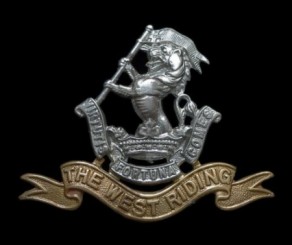
26 November 1915
BARNOLDSWICK N.C.O.’s PROMOTION
Two other well-known Barlickers who have been visiting the town this week are Company Sergt.-Major Fred Green and Sergt. Frank Watson (Swedish drill instructor), both belonging to the 9th Duke of Wellington’s, who went out to France at the beginning of July. The former, whose home is at 18, Bolland Street, was promoted on the field about two months ago, his predecessor being killed by a bullet in the neighbourhood of Ypres. Sergt. Watson speaks confidently of the British position in that hotly contested region, where our troops have gradually gained the upper hand. They have the measure of the enemy, he says, and can now reply with five shells to one. Still there is need for more men to man the trenches, which have latterly become so foul that it is well nigh impossible for the men to occupy them for more than 48 hours at a stretch. Even under this reduced period the number of men who suffer from ‘trench foot’ (a complaint akin to frost bite) is daily becoming larger on account of the severe weather conditions.
A MUSICAL INTERLUDE
Referring to his bosom friend Pte. Gilbert Snowdon (another Barlicker in the same regiment, now a bomb thrower), Sergt. Watson related an amusing incident. A few weeks ago Snowdon, who at the time of enlistment was a player in the Barnoldswick Brass Band, wrote to a friend at home requesting an old cornet to be sent out to him, with which to relieve the tedium of trench warfare. The instrument was duly forwarded and has answered the purpose admirably. One day he entertained his comrades with a number of patriotic and sentimental selections, including ‘Home, Sweet Home’, observing that the latter ‘touched’ his comrades in a tender spot, the soloist suddenly changed the tune to ‘Has anybody seen a German Band?’ The effect was almost instantaneous, for before he had got through the first verse there was a regular fusillade from the enemy trenches a short distance away, and a general stampede to cover on the part of Gilbert and his audience.
A GERMAN TRENCH RUSE
Pte. John Wade, another Barnoldswick man in the 9th Duke’s, who has been at home (Bethel Street) this week, said the Battalion were kept in reserve five days before the attack at Loos ready to march at a minute’s notice. When they did move forward it was found that they could not arrive in time. The Germans in the first line trenches have their rifles fixed on tripods, each rifle being fitted with a periscopic sight that reduces the distance to about one tenth of the actual. “That is one reason,” he said “ why so many of our men have been hit in the head.” One night our Scouts crept up to a first-line enemy trench and found it practically destroyed with the exception of one man to every 100 yards or so, who walked backward and forward pulling a trigger here and there as he passed in order to keep up the deception that the trench was fully manned. The bulk of their men were resting in dug-outs meanwhile. Pte. Wade is not impressed with the scenery of Belgium, though he admits that the cities – those that remain – are beautiful. As he came through ruined Ypres on his way home the Germans started shelling it on three sides, and another shell dropped on the station at Poperinge just as the train was leaving.
31 March 1916
ANOTHER BARNOLDSWICK D.C.M.
According to a letter received a few days ago by Mr. Sam Green, Moorside Farm, Barnoldswick from his brother in France, Company-Sergt.-Major Fred Green, of the 9th Battalion Duke of Wellington’s Regiment, has been awarded the D.C.M. He is a son of Mr. John Green, 13, Bolland Street, Barnoldswick, and has been at the Front since August last, but was home on leave shortly after Christmas. He is 30 years of age. The letter, which contains no details of the services for which the distinction has been awarded, runs as follows:–
“Thanks very much for the nice parcel which I have just opened, I have just come down from the trenches to our billet. I have been up to look round before taking the company up tonight. They seem very fair trenches and much quieter than those we have been used to. Probably we shall liven them up a bit when we get there. Our general doesn’t believe in letting them rest too much. Well, I have got the D.C.M. all right, and am wearing the ribbon; but I expect to wait some time before I get the medal – most likely when some big General comes around when we are out for a rest. The weather is mending up beautifully and it is quite like summertime. I can see big things coming off round here before very long, and then we shall be over the top again and on our way to Germany.
“… (censored) is a very big place and in some parts not much damaged by shellfire. Many of the residents are still here and there are some big shops open where we can buy anything – but they often forget to make us pay. Well, that’s about all this time. Remember me to all at Moorside and don’t forget to tell Jack I shall be home again before long.”
07 April 1916
BARNOLDSWICK’S THIRD D.C.M.
The accompanying portrait is of Company Sergeant Major Fred Green, 9th Battalion Duke of Wellington’s Regiment, who, as announced last week, has been awarded the D.C.M. for conspicuous gallantry and ability.
“During operations (the official record states) he rendered great assistance to his company officers, and by his courage and example kept the men in good spirits.”
Company Sergeant Major Green, who had been previously mentioned in despatches, is the third Barnoldswick man in the British Expeditionary Force upon whom the medal has been bestowed.
30 June 1916
BARNOLDSWICK’S FOURTH D.C.M.
Another Barnoldswick soldier, Sergeant James Bury, of the 1/6th Duke of Wellington’s Regiment (grenade company), has been awarded the D.C.M. (for conspicuous gallantry). Sergt. Bury is the son of Mr. and Mrs. J. Bury, 6, East Parade, Barnoldswick. He went out to France in April 1915 with the rank of Corporal. The official announcement of the exploit, which earned him the coveted distinction, reads as follows:– “For conspicuous gallantry. When the enemy bombed a post of which he was in charge, causing some casualties, he stuck to the post and bombed the enemy back single-handed. This is not the first occasion on which he has shown great courage.”
In a letter to his parents a few days ago Sergt. Bury writes:– “I have left the convalescent depot and am now at the base. You will no doubt know that I have got the D.C.M. There are a lot of the boys here – Dave Russell, and lots of my old bombers. I can see us having some fun when we get back up the line. I went in front of ‘Bones’ this morning and he is doping me with iron tonic or something like that, but I am marked ‘active’ and there isn’t anything wrong with me. I have seen a lot of Barnoldswickers and they are all in the pink. I am going down the town if I get a chance before I renew my acquaintance with Fritz.”
Sergt. Bury was, prior to the outbreak of war, a prominent member of the Barnoldswick Football Club, and worked as a weaver at Messrs. Dugdale and Dewhurst’s Wellhouse Mill. One of his brothers is in the Coldstream Guards.
The previous holders of the Distinguished Conduct Medal are: Pte. Fred Bracewell, Sergt. P. B. Garratt and Quarter-Master Sergeant J. [F.] Green.
21 July 1916
A BARNOLDSWICK D.C.M. AMONGST THE KILLED
Mr. John Green, 13, Bolland Street, Barnoldswick, yesterday received official information of the death of his eldest son, Company-Sergeant Major Fred Green, D.C.M., 9th Battalion Duke of Wellington’s Regiment (‘C’ Company), who was killed in action in France on the 7th inst. The news confirms that received from two Barnoldswick comrades, who wrote home a week ago. Sergeant-Major Green was 30 years of age.
28 July 1916
BARNOLDSWICK CASUALTY LIST – THE LATE COMPANY-SERGEANT-MAJOR GREEN
The following letter (received too late for publication last week) from a Barnoldswick comrade in the 9th Battalion Duke of Wellington’s Regiment, tells how Company-Sergt.-Major Fred Green, who was awarded the D.C.M. last March met his death. The writer is Lance-Corpl. Frank Edmondson:–
“I have just had time to write. I have once more come out of the battle without a scratch. I dare say you will have read all about the great offensive in which we were engaged. I have been very lucky. Sam Woodhead was wounded next to me and three killed. Fred Green was wounded; he got killed by a shell while bringing him (Woodhead) down to the dressing station. W. Dacre and W. Boocock were also wounded, and a lad named Leach (all from Barnoldswick) was killed.”
Happily the information in regard to Leach turned out incorrect, for though Sergt. Wm. Leach was officially reported killed, his wife, who resides at 7 Stewart Street, had received a letter from him a day or two previously saying he was at a casualty clearing station, having been struck on the head by a piece of shrapnel “Luckily it did not penetrate the bone. I am going on splendidly, and very soon hope to see you in England.”
Sergt. Leach joined the army soon after the outbreak of hostilities. He was a playing member of the Barnoldswick Football Club.
20 October 1916
BARNOLDSWICK’S FIFTH D.C.M.
News is to hand that Pte. John Edward Pickup, son of Mr. and Mrs. James Pickup, Cherrydene, Barnoldswick, has been awarded the Distinguished Conduct Medal. Pte. Pickup, who is 23 years of age, went out with the Duke of Wellington’s in April 1915 as a stretcher-bearer, and is the third Barnoldswick stretcher-bearer to earn that distinction, the others being Sergeant P.H. Garratt and Pte. Fred Bracewell. Two other Barlickers in the same regiment who were awarded the D.C.M. were Co.-Sergt.-Major Green (since killed) and Sergeant James Bury.
In a letter acquainting his parents of the fact, Pte. Pickup says:– “I have just been presented with the D.C.M. ribbon, and I shall be receiving the medal very likely before long.”
Before joining the Army he worked as a weaver at Messrs. Albert Hartley and Co.’s, Long Ing.









No comments yet.